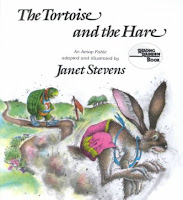 Book: That Is NOT a Good Idea! by Mo Willems
Book: That Is NOT a Good Idea! by Mo Willems
Puppets: Goose, Wolf (or Fox), Goslings (3-5)
Props: Pot (big enough to fit Wolf puppet); Veggies (optional) Puppet Stage (optional)
Presenters: 2, plus 2-4 kids from audience
Audience: Family Storytime (mostly 3-6 year olds)
Not all Mo Willems books are easily adaptable for presentation, but that doesn't mean we don't look carefully at every new one that comes along. It took a bit of tinkering, but
That Is Not a Good Idea! worked out very nicely when Sheila and I had "Mo Willems" as our Family Storytime theme last week. In the book, Fox tempts Goose to accompany him, step by step, to the woods, to his kitchen, and into his soup pot. Goose plays along and has a trick of her own at the end. Meanwhile Goose's little Goslings act as a kind of a chorus: Each time Goose agrees to one of Fox's sly suggestions, they yell out the title of the book. The joke is that they're really warning
Fox, not Goose, that things will end badly for him.


We used our puppet stage and regular hand puppets for Goose (maybe not technically a goose, but Sheila made this great bird puppet years ago and I use it every chance I get) and Wolf (we
have a Fox puppet, but our Wolf is just a bit more expressive). They appear on stage, Wolf makes a suggestion ("Shall we walk in the woods...?"), Goose agrees, then both exit.
For the chorus of Goslings, we scanned, enlarged, and laminated the guys
from the book, then stuck them onto paint sticks. My original idea was
that they would appear above the puppet stage, looking down on the
other two. Then Sheila had a better idea: we had four kids from the
audience come up to hold one Gosling each next to the stage, while
Sheila held the first one. This worked even better for their "chorus"
role. Sheila ran them through their line before we started, adding that
they would say "really not..." then "really
really not..." and so on. She also encouraged the rest of the audience to join in on the refrain, and they did.

We didn't bother with any backdrops; Wolf just said: "Now that we're in the deep dark woods..." and that was enough. Each time the audience chimed in with the "..not a good idea" part, Wolf would pop back up and say something: "you be quiet," or "it is
too a good idea." That's not in the book, but we felt like adding interaction between Wolf and Goslings helped establish the chorus' role and Wolf's plans.
When it's finally time for soup, Wolf puts a big plastic pot on the stage, adds a few vegetables to draw it out (and a lollipop just to be silly) and finally prepares to add the last ingredient, which everyone thinks will be Goose. The Goslings give their last warning, then Goose grabs Wolf and stuffs
him in the pot. First, though, she explains that the Goslings "
did try to warn Wolf..." We wanted to make that clever twist very clear to everyone in the audience, short of spelling it out directly.
Once Wolf is in the pot, Goose calls the Goslings down to have lunch with her. The kids bring their stick figures over, Goose takes a bite or two of Wolf, and the kids, following Sheila's lead, have their Goslings gather round the pot for their own share. Sometimes we find simple ways to soften the ending of a story that ends gruesomely, trying to respect the delicate nature of three and four year olds without compromising the story.....not this time. We just followed the perfect ending of the book and that Wolf got eaten up. The story was just so silly and so neatly constructed, it was by far the most satisfying way to end it (for the storytellers, as well as for the hungry geese).
 We just wrapped up our Fall Programming season this week at our library. We divide our program year into quarters and always have a break in between, ranging from two to four weeks. We use the time to plan storytimes and other programs, develop a new story or two, and put some energy into sometimes-neglected parts of our jobs, such as collection development (not like we don't do that all year, it's just that December's a great time to catch up).
We just wrapped up our Fall Programming season this week at our library. We divide our program year into quarters and always have a break in between, ranging from two to four weeks. We use the time to plan storytimes and other programs, develop a new story or two, and put some energy into sometimes-neglected parts of our jobs, such as collection development (not like we don't do that all year, it's just that December's a great time to catch up). 











































+-+cover.jpg)






